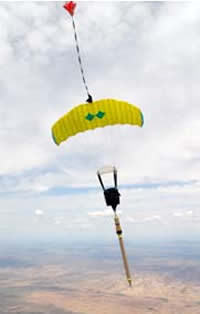MQ-1B, the Armed configuration of the General Atomics Predator UAV operated by the US Air Force is now standard configuration for this unmanned aircraft, flown on routine missions from Balad air force base in Iraq. This UAV differs from the original Predator by the installation of two hard points carrying Hellfire missile launchers. These weapons are routinely used on armed reconnaissance missions. Another version of the Predator known as Warrior is currently under development for the US Army Extended Range / Multi Purpose (ER/MP) program. This aircraft will be fitted with four external carriage hardpoints loading four Hellfire missiles. The Army also considers adapting the Northrop Grumman Viper Strike and a unified dispenser which can carry various gravity dropped weapons, as well as supplies to support Special Forces deep inside enemy territory. 
The USAF unmanned fleet will soon be augmented by a larger, more advanced system known as the Reaper MQ-9A. This UAV was designed from the beginning as a “Hunter-Killer” system. Compared with the limited strike capability of current UAVs flying at altitudes of 15,000-25,000 ft, the Reaper will be able to loiter at an altitude of up to 50,000 feet over a mission area, for up to 30 hours, armed with some 16 Hellfire II missiles or enhanced capability, with combination of Hellfires and precision guided bombs, such as GBU-38 JDAM or GBU-12 laser guided bombs (500lbs each). The aircraft will have a maximum gross takeoff weight of 10,000 pounds ( 5 Tons)s. It will be powered by a turbo-prop engine and have a wider fuselage, storing the fuel and payloads necessary for extended missions. Weapon guidance techniques can also utilize advanced parafoil decelerators, such as the Micro Onyx, which canguide a warhead to a hit a precise target, marked by GPS coordinates. The manufacturer claims this concept is more effective, lighter and costs less than conventional aerial guided weapons. Similar systems are already used within the Steel Eagle program, for the emplacement of aerial delivered unattended ground sensors (UGS).
 The US Air Force has requested funding of about $825 million for 74 Predators over the next six years, augmenting the 68 now in service. Thirty-two of those would be MQ-9 Reapers. In total, 15 squadrons will be operational. The USAF is currently testing more weapons with Predator and eventually Reaper, including the Viper Strike laser guided munition, small diameter bomb, laser guided munitions and Stinger air/air missile. Employment of air-to-air weapons like Raytheon’s AIM-9 Sidewinder and AIM-120 Advanced Medium-Range Air-to-Air Missile may also be evaluated at some point. Other weapons could include the PASSM, a more accurate and versatile precision attack missile proposed as a future alternative for the air-launched Hellfire II.
The US Air Force has requested funding of about $825 million for 74 Predators over the next six years, augmenting the 68 now in service. Thirty-two of those would be MQ-9 Reapers. In total, 15 squadrons will be operational. The USAF is currently testing more weapons with Predator and eventually Reaper, including the Viper Strike laser guided munition, small diameter bomb, laser guided munitions and Stinger air/air missile. Employment of air-to-air weapons like Raytheon’s AIM-9 Sidewinder and AIM-120 Advanced Medium-Range Air-to-Air Missile may also be evaluated at some point. Other weapons could include the PASSM, a more accurate and versatile precision attack missile proposed as a future alternative for the air-launched Hellfire II.
During the recent conflict in Lebanon and the ongoing conflict between Israel and the Palestinians, the IDF was reported to be using armed UAVs for attacking suspected terrorists in the West Bank and Gaza. The type of platforms or weapons used are classified, but according to industry briefings, several Israeli companies are involved in the development and fielding of lightweight, precision strike weapons and warheads designed specifically for operation in urban environments.
Read additional parts of this article:
- Smart Weapons for UAVs
- Weaponized UAVs
- Smart Weapons for UAVs
- Evolution of UAV Employed Missiles
- Lightweight Weapons for Autonomous Platforms
- Gravity Dropped Munitions for UAVs
- Targeting at the pixel
- Loitering Autonomous Weapons
- Grouping in Constellations
- Empowered by the Swarm
- Weaponizing Unmanned Combat Helicopters
















